The Chinese space program reached its next objective on Monday with the launch of its fourth unmanned Shenzhou spacecraft. Officials from the country’s space agency say that everything has gone according to plan, and the spacecraft is functioning normally. The spacecraft is designed to be identical with a future, manned version – which China hopes to launch some time in 2005.
Dark Energy Dominated Universe
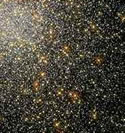
Image credit: Hubble
A new paper published by Dartmouth university researcher Brian Chaboyer reports that our universe might be dominated by “dark energy”; a mysterious force that seems to be causing objects in the universe to accelerate away from each other. The researchers came to this conclusion by calculating the age of distant globular clusters, and matching it to the expansion age of the universe. The numbers only match if the universe has been accelerating up until now.
A Dartmouth researcher is building a case for a “dark energy”-dominated universe. Dark energy, the mysterious energy with unusual anti-gravitational properties, has been the subject of great debate among cosmologists.
Brian Chaboyer, Assistant Professor of Physics and Astronomy at Dartmouth, with his collaborator Lawrence Krauss, Professor of Physics and Astronomy at Case Western Reserve University, have reported their finding in the January 3, 2003, issue of Science. Combining their calculations of the ages of the oldest stars with measurements of the expansion rate and geometry of the universe lead them to conclude that dark energy dominates the energy density of the universe.
?This finding provides strong support for a universe which is dominated by a kind of energy we?ve never directly observed,? says Chaboyer. ?Observations of distant supernova have suggested for a few years that dark energy dominates the universe, and our finding provides independent evidence that the universe is dominated by this type of energy we do not understand.?
The researchers came to this conclusion as they were refining their calculations for the age of globular clusters, which are groups of about 100,000 or more stars found in the outskirts of the Milky Way, our galaxy. Because this age (about 12 billion years old) is inconsistent with the expansion age for a flat universe (only about 9 billion years old), Krauss and Chaboyer came to the conclusion that the universe is expanding more quickly now than it did in the past.
The only explanation, according to Chaboyer and Krauss, for an accelerating universe is that the energy content of a vacuum is non-zero with a negative pressure, in other words, dark energy. This negative pressure of the vacuum grows in importance as the universe expands and causes the expansion to accelerate.
Original Source: Dartmouth College News Release
The Path of Earth’s Asteroid Companion
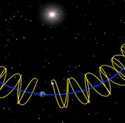
Image credit: NASA
Asteroid 2002 AA29 happens to share almost the same orbit as the Earth as it goes around the Sun, getting closer and further as it interacts with our planet’s gravity. On January 8, 2003, the asteroid will make its closest approach for almost a century, getting only 5.9 million kilometers away from us. There is no possibility that it can ever hit our planet, though, as interference from the Earth’s gravity keeps it at bay – causing it to trace out a strange horseshoe shape as it goes around the Sun.
The first asteroid discovered to orbit the Sun in nearly the same path as Earth will make its closest approach to our planet this month before scurrying away for 95 years.
The space rock, measuring about 60 meters (approximately 200 feet) across, is like a mouse teasing a cat. According to an international team of astronomers, including a researcher from NASA’s Jet Propulsion Laboratory in Pasadena, Calif., the asteroid approaches the Earth, first on one side and then on the other. The team’s report appeared in the October 2002 issue of the journal Meteoritics & Planetary Science.
The asteroid, named 2002 AA29, traces an unusual horseshoe pattern relative to Earth. The asteroid alternately leads and follows Earth around the Sun without ever passing it. “In some ways, the Earth and this asteroid are like two racecars on a circular track,” said JPL’s Dr. Paul Chodas, who discovered the object’s unusual motion. “Right now the asteroid is on a slightly slower track just outside Earth’s, and our planet is catching up.”
On January 8, 2003, the tiny body will come within approximately 5.9 million kilometers (3.7 million miles) of Earth, its closest approach for almost a century. “Unlike racecars, the two bodies will not pass when they approach each other,” Chodas said. “Instead, the combined gravitational effects of the Earth and Sun will nudge the asteroid onto a slightly faster track just inside Earth’s, and it will begin to pull ahead.”
In 95 years, the asteroid will have advanced all the way around to where it is catching up to Earth from behind. A similar interaction with gravity from both Earth and the Sun will then push the asteroid back onto a slower outside track, and the pattern will repeat. To an observer moving with the Earth, the asteroid appears to trace out a horseshoe pattern.
“There’s no possibility that this asteroid could hit Earth, because Earth’s gravity rebuffs its periodic advances and keeps it at bay,” said Dr. Don Yeomans, JPL manager of NASA’s Near Earth Objects Program Office. “The asteroid and Earth take turns sneaking up on each other, but they never get too close.”
The team’s calculations show that in about 600 years, the asteroid may begin looping around Earth like a tiny, distant quasi-moon. “The asteroid will appear to orbit the Earth at that time, but in fact it will be too far away to be considered a true satellite of our planet,” Chodas said. “Our calculations indicate the space rock will circle the Earth as a quasi-satellite for about 40 years before resuming its horseshoe orbital pattern.”
Other members of the team investigating this object include Dr. Martin Connors, Athabasca University, Canada; Dr. Seppo Mikkola, University of Turku, Finland; Dr. Paul Wiegert, Queen’s University, Canada; Dr. Christian Veillet, Canada-France-Hawaii Telescope, Hawaii; and Dr. Kim A. Innanen, York University, Canada.
JPL is a division of the California Institute of Technology in Pasadena, Calif.
Original Source: NASA/JPL News Release
China Plans for Human Flight in 2003
Just days after the launch of the Shenzhou-IV spacecraft, an official from the Chinese Space Agency announced to the country’s newspaper that they plans to put humans into space some time in the last half of 2003. According to the agency, the Shenzhou-IV has all the facilities on board to support humans, so it’s their next logical step to become the third nation to put humans into space. It’s unknown when Shenzhou-IV is expected to return to Earth.
Proton Launches Canadian Satellite
A Russian-built Proton M rocket launched a Canadian Nimiq2 rocket on Sunday evening. The rocket lifted off from the Baikonur Cosmodrome in Kazakhstan at 2317 GMT (6:17pm EST), and released the satellite into a transfer orbit 6 hours, 53 minutes later. Nimiq 2 will provide direct broadcasting services across Canada.
Boeing and Hughes Charged by US State Dept.
The US State Department announced on Wednesday that it has charged aerospace firms Boeing and Hughes with 123 violations of illegally sharing space technology with China. If the charges are upheld, the two companies could face up to $60 million in fines, and be prohibited from selling “controlled technologies” to other countries. The two companies say they did nothing wrong, and have already been fighting these allegations for several years.
Hubble Images the Little Ghost Nebula
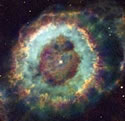
Image credit: Hubble
The latest image release from the Hubble Space Telescope is of the “Little Ghost Nebula”; a.k.a. NGC 6369, located several thousand light years from Earth in the constellation of Ophiuchus. The nebula was created when a star like our own Sun entered the final stages of its life and expelled its outer layers into space. The glow is caused by the ultraviolet light streaming from the star and heating up the surrounding gas and dust.
NASA’s Hubble Space Telescope has recently obtained images of the planetary nebula NGC 6369. This object is known to amateur astronomers as the “Little Ghost Nebula,” because it appears as a small, ghostly cloud surrounding the faint, dying central star. NGC 6369 lies in the direction of the constellation Ophiuchus, at a distance estimated to be between about 2,000 and 5,000 light-years from Earth.
When a star with a mass similar to that of our own Sun nears the end of its lifetime, it expands in size to become a red giant. The red-giant stage ends when the star expels its outer layers into space, producing a faintly glowing nebula. Astronomers call such an object a planetary nebula, because its round shape resembles that of a planet when viewed with a small telescope.
The Hubble photograph of NGC 6369, captured with the Wide Field Planetary Camera 2 (WFPC2) in February 2002, reveals remarkable details of the ejection process that are not visible from ground-based telescopes because of the blurring produced by the Earth’s atmosphere.
The remnant stellar core in the center is now sending out a flood of ultraviolet (UV) light into the surrounding gas. The prominent blue-green ring, nearly a light-year in diameter, marks the location where the energetic UV light has stripped electrons off of atoms in the gas. This process is called ionization. In the redder gas at larger distances from the star, where the UV light is less intense, the ionization process is less advanced. Even farther outside the main body of the nebula, one can see fainter wisps of gas that were lost from the star at the beginning of the ejection process.
The color image has been produced by combining WFPC2 pictures taken through filters that isolate light emitted by three different chemical elements with different degrees of ionization. The doughnut-shaped blue-green ring represents light from ionized oxygen atoms that have lost two electrons (blue) and from hydrogen atoms that have lost their single electrons (green). Red marks emission from nitrogen atoms that have lost only one electron.
Our own Sun may eject a similar nebula, but not for another 5 billion years. The gas will expand away from the star at about 15 miles per second, dissipating into interstellar space after some 10,000 years. After that, the remnant stellar ember in the center will gradually cool off for billions of years as a tiny white dwarf star, and eventually wink out.
Original Source: Hubble News Release
XMM Helps Uncover Exotic Matter
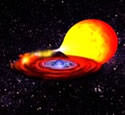
Image credit: ESA
Shortly after the Big Bang, it’s believed that all the matter in the Universe was broken up into its smallest components. But astronomers believe that some of this original material may be created again inside very dense neutron starts. Using the XMM-Newton space telescope, a team of astronomers are attempting to calculate the “compactness” of several neutron stars – to see if they go beyond the density of normal matter.
A fraction of a second after the Big Bang, all the primordial soup of matter in the Universe was ‘broken’ into its most fundamental constituents. It was thought to have disappeared forever. However scientists strongly suspect that the exotic soup of dissolved matter can still be found in today’s Universe, in the core of certain very dense objects called neutron stars.
With ESA’s space telescope XMM-Newton, they are now closer to testing this idea. For the first time, XMM-Newton has been able to measure the influence of the gravitational field of a neutron star on the light it emits. This measurement provides much better insight into these objects.
Neutron stars are among the densest objects in the Universe. They pack the mass of the sun inside a sphere 10 kilometres across. A sugar cube-sized piece of neutron star weighs over a billion tonnes. Neutron stars are the remnants of exploding stars up to eight times more massive than our Sun. They end their life in a supernova explosion and then collapse under their own gravity. Their interiors may therefore contain a very exotic form of matter.
Scientists believe that in a neutron star, the density and the temperatures are similar to those existing a fraction of a second after the Big Bang. They assume that when matter is tightly packed as it is in a neutron star, it goes through important changes. Protons, electrons, and neutrons ? the components of atoms – fuse together. It is possible that even the building-blocks of protons and neutrons, the so-called quarks, get crushed together, giving rise to a kind of exotic plasma of ‘dissolved’ matter.
How to find out? Scientists have spent decades trying to identify the nature of matter in neutron stars. To do this, they need to know some important parameters very precisely: if you know a star?s mass and radius, or the relationship between them, you can obtain its compactness. However, no instrument has been advanced enough to perform the measurements needed, until now. Thanks to ESA’s XMM-Newton observatory, astronomers have been able for the first time to measure the mass-to-radius ratio of a neutron star and obtain the first clues to its composition. These suggest that the neutron star contains normal, non-exotic matter, although they are not conclusive. The authors say this is a ?key first step? and they will keep on with the search.
The way they got this measurement is a first in astronomical observations and it is considered a huge achievement. The method consists of determining the compactness of the neutron star in an indirect way. The gravitational pull of a neutron star is immense – thousands of million times stronger than the Earth?s. This makes the light particles emitted by the neutron star lose energy. This energy loss is called a gravitational ‘red shift’. The measurement of this red shift by XMM-Newton indicated the strength of the gravitational pull, and revealed the star?s compactness.
“This is a highly precise measurement that we could not have made without both the high sensitivity of XMM-Newton and its ability to distinguish details,” says Fred Jansen, ESA’s XMM-Newton Project Scientist.
According to the main author of the discovery, Jean Cottam of NASA?s Goddard Space Flight Center, “attempts to measure the gravitational red shift were made right after Einstein published the General Theory of Relativity, but no one had ever been able to measure the effect in a neutron star, where it was supposed to be huge. This has now been confirmed.”
Original Source: ESA News Release
Soyuz Undocks from Station, Lands Safely
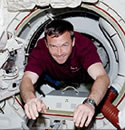
Image credit: NASA
A Russian-Belgian crew of cosmonauts undocked from the International Space Station on Sunday and piloted their Soyuz spacecraft back to Earth and landed safely in rural Kazakhstan. During their 10-day mission in space, the cosmonauts performed a series of experiments including research into the effects of weightlessness and radiation on genes. All three crew members are reported to be in good health.
A Russian-Belgian cosmonaut crew departed the International Space Station today after delivering a new Soyuz return vehicle to the complex and conducting more than a week?s worth of joint scientific experiments with the residents on board.
Russian ?taxi crew? Commander Sergei Zalyotin, European Space Agency Flight Engineer Frank DeWinne from Belgium and Russian Flight Engineer Yuri Lonchakov undocked the Soyuz TM-34 capsule from the Zarya Control Module?s nadir docking port at 2:44 p.m. Central time (2044 GMT) and backed away from the ISS to a safe distance through a series of thruster firings. The Soyuz TM-34 vehicle arrived at the ISS in April. Left behind docked to the Russian Pirs Docking Compartment of the ISS is the new Soyuz TMA-1 return craft which carried Zalyotin, DeWinne and Lonchakov from the Baikonur Cosmodrome in Kazakhstan during their launch on Oct. 30. They arrived at the ISS on Nov. 1.
A fresh Soyuz is delivered to the ISS every six months to provide an assured return capability for station residents in the unlikely event a problem would force them to come home prematurely. The new Soyuz is designed to accommodate larger or smaller crewmembers, and is equipped with upgraded computers, a new cockpit control panel and improved avionics.
The Expedition 5 crewmembers ? Commander Valery Korzun, NASA ISS Science Officer Peggy Whitson and Flight Engineer Sergei Treschev ? bid the ?taxi? crew farewell earlier today before closing hatches between the station and the Soyuz return vehicle.
Later today, Zalyotin will perform a deorbit maneuver using the Soyuz thrusters to begin the descent back home for a landing on the steppes of Kazakhstan at 6:04 p.m. Central time (0004 GMT Nov. 10, 5:04 a.m. Kazakhstan time Nov. 10).
The departure of the ?taxi? crew sets the stage for the launch of the shuttle Endeavour on the STS-113 mission early Monday to bring a new crew of residents to the ISS to replace Korzun, Whitson and Treschev, who have been in space since June. Endeavour?s crew, led by Commander Jim Wetherbee, will also deliver the Port One (P1) truss segment to the ISS, the fourth of 11 such trusses that will form the backbone for the ISS for the addition of new modules and power-producing solar arrays.
Information on the crew’s activities, future launch dates, as well as station sighting opportunities from anywhere on the Earth, is available on the Internet at: http://spaceflight.nasa.govDetails on station science operations can be found on an Internet site administered by the Payload Operations Center at NASA’s Marshall Space Flight Center in Huntsville, Ala., at: http://www.scipoc.msfc.nasa.govThe next ISS status will be incorporated into the STS-113 mission status reports beginning after the launch of Endeavour, or sooner, if developments warrant.
Original Source: NASA News Release
Oxygen Leak Delays Launch
The launch of the space shuttle Endeavour was pushed back at least a week when engineers discovered an oxygen leak in the cabin ? only a few hours before the shuttle was scheduled to launch. The leaking oxygen transfer line is going to be hard to fix as it?s located in a hard to reach area under the payload bay. Once the shuttle does launch (now scheduled for some time between 0 and 0400 GMT on Tuesday, November 19), it will carry a replacement crew to the International Space Station.
